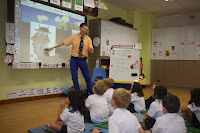The past decade has seen huge changes in the types of technology
standards that most schools have. Even two years ago the SAS technology
standards were lists of concrete skills organized around types of tools such as
word processors, spreadsheets, and desktop layout programs. Depending upon
grade level, the standards looked something like this:
● Insert header and
footer into a Word document.
● Create a graphic in a
paint program and export it as a JPEG file.
● Convert spreadsheet
data into a bar graph.
In January 2009 SAS adopted the Technology Integration Framework:
Grades K-12.1 (Please see details at end of this post.) The framework is based
on the National
Educational Technology Standards for Students or (NETS-S)2. The International Society for Technology in Education who
developed the standards, explains them in this way:
NETS are the standards for evaluating the skills and knowledge
students need to learn effectively and live productively in an increasingly
global and digital world.
Simply being able to use technology is no longer enough. Today's
students need to be able to use technology to analyze, learn, and explore.
Digital age skills are vital for preparing students to work, live, and
contribute to the social and civic fabric of their communities.3
The adoption of the SAS Technology Integration Framework marks
two major shifts as described below.
Our framework is well written, but it is not written in
kid-friendly language. We use the terms 4 below to make it more
accessible to our students. I’ve also listed a few examples in each section.
Make It!
Use technology to show your creativity.
- Art students creating stop motion movies to animate their art.
- Grade 3 students creating digital posters to explain the board game they designed.
- Grade 4 students creating a collage or scrapbook page with photos from the year.
Say It!
Use technology to communicate.
- Grade 3 classes Skyping grandparents to learn about inventions.
- Grade 4 students working on oral fluency through choral reading podcasts.
- Grade 5 students Skyping family members to give them a weekly update on their activities and progress.
Share it!
Use technology to collaborate.
- Using the comment feature in Google Docs to give their writing partners feedback on first drafts.
- Using Mind Meister mind mapping software in our Google Apps suite to collaboratively reflect on story elements.
Find It!
Use technology for research.
- Our librarians Kate Brundage and Rosa Shin-Gay teach search skills during library classes. Students apply these skills in the classroom with the assistance of teachers.
- Exploring fake websites to learn how to check the validity of web site sources.
Solve It!
Use technology to think critically, solve problems and make
decisions.
- Grade 3 students gather data and analyze data on developing and developed countries.
- Grade 4 play the Great Ocean Rescue computer simulation to gather information, think critically and make decisions to solve problem affecting our oceans.
Protect It!
Use our core values whenever using technology.
· Grade 3 students learn
to be responsible for keeping their password and other personal information
safe online.
· Grade 4 students are
respectful when they leave appropriate comments on each other’s blogs.
· Grade 5 students learn
about their digital footprint and put those skills to use as they start using
school email and blogging.
· All grades learn about
their responsibility to help stop cyber bullying and the compassionate way to
treat students who are being bullied.
Use It!
Use technology devices and programs to improve your learning.
· Students in all grades
learn a wide variety of technology skills as they complete classroom projects.
These skills include but are not limited to word processing, typing, movie
making, podcasting, desktop publishing, graphical design, graphing, mind
mapping and using spreadsheets.
· They use a variety of
devices including computers, ipads, cameras, and digital microscopes.
Technology
Integration Framework: Grades K-12
Standard 1: Creativity and Innovation
Students
demonstrate creative thinking, construct knowledge, and develop innovative
products and processes using technology.
Standard 2: Communication and Collaboration
Students use
digital media and environments to communicate and work collaboratively,
including at a distance, to support individual learning and contribute to the learning
of others.
Standard 3: Research and Information Fluency
Students apply
digital tools to gather, evaluate, and use information.
Standard 4: Critical Thinking, Problem Solving,
and Decision Making
Students use
critical thinking skills to plan and conduct research, manage projects, solve
problems, and make informed decisions using appropriate digital tools and resources.
Standard 5: Digital Citizenship
Students
understand human, cultural, and societal issues related to technology and
practice legal and ethical behavior.
Standard 6: Technology Operations and Concepts
Students
demonstrate a sound understanding of technology concepts, systems, and
operations.
For more detailed information visit: http://bit.ly/UPx9Mi.
[1] SAS Technology Framework: Grades K-12, (January 2009). http://www.sas.edu.sg/uploaded/SAS/Learning_at_SAS/OOL/docs/curriculum/K12_Technology_Integration_Framework.pdf
2 NETS for Students, International Society
for Technololgy in Education (2012). http://www.iste.org/docs/pdfs/nets-s-standards.pdf?sfvrsn=2
3 NETS for Students, International Society
for Technololgy in Education (2012).



